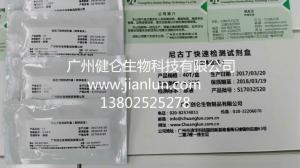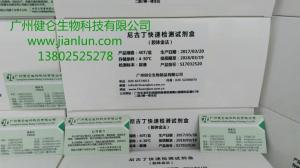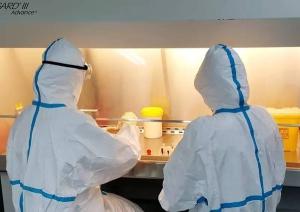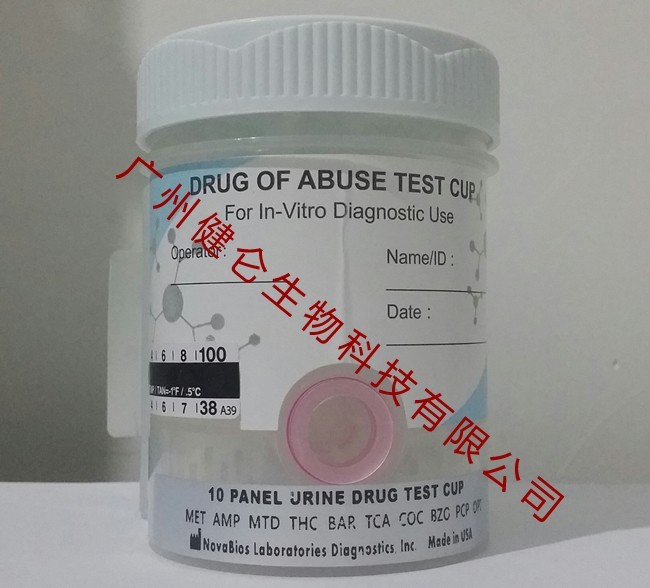


|



| 产地 | 中国 |
| 品牌 | CL |
| 货号 | CL03 |
| 保存条件 | 愱说明书要求保存 |
| 保质期 | 有效期之前个月 |
样本释放剂说明书
广州健仑生物科技有限公司
使用说明书
【产品名称】样本释放剂
【包装规格】20测试/盒 (溶液I:20×1 Test/瓶;溶液II:20 Test/瓶)
50测试/盒 (溶液I:50×1 Test/瓶;溶液II:50 Test/瓶X 1 )
100测试/盒 (溶液I:100×1 Test/瓶;溶液II:50 Test/瓶X 2)
检测方法
(一)放散液抗体检测
1.试管法
(1)标识试管并加入2%已知血型的红细胞悬液1滴,加入放散液2滴混匀,置37℃水浴孵育30分钟。
(2)取出试管并用生理盐水洗涤细胞3次,*一次洗涤后彻底倾去洗涤液并用吸水纸吸干试管口的水。
(3)加入2滴抗人球蛋白试剂并混匀,1000g离心15秒。
(4)轻轻震摇试管,肉眼或显微镜下判读凝集结果。
2. 微柱凝胶法
(1)取抗人球蛋白检测卡并做好标识,向孔中加入已知血型的0.8~1%红细胞悬液50μL。
(2)上述孔中加入放散液50μL,置37℃孵育器中孵育15分钟。用卡式专用离心机离心。
(3)取出微柱凝胶卡,肉眼或判读仪判读凝集结果。
(二)解离释放后的红细胞抗原检测
1.以IgM型单克隆抗体检测红细胞抗原
(1)将解离释放后的红细胞用生理盐水洗涤6次,然后用生理盐水配制成2%左右的红细胞悬液。
(2)加2 滴抗体到一支洁净试管中并标记。
(3)向试管中加入1 滴2%的上述待检红细胞悬液,轻轻混匀,1000g离心15秒。
(4)轻轻震摇试管,肉眼或显微镜下判读凝集结果。
2. 以IgG型单克隆抗体检测红细胞抗原
(1)将解离释放后的红细胞用生理盐水洗涤6次,然后用生理盐水配制成2%左右的红细胞悬液。
(2)加2 滴抗体到一支洁净试管中并标记。
(3)向试管中加入1 滴2%的上述待检红细胞悬液并混匀,置37℃水浴箱中孵育30分钟。
(4)取出试管并用生理盐水洗涤细胞3次,*一次洗涤后彻底倾去洗涤液并用吸水纸吸干试管口的水。
(5)加入2滴抗人球蛋白试剂并混匀,1000g离心15秒。
(6)轻轻震摇试管,肉眼或显微镜下判读凝集结果。
【参考值】本品为定性试剂,不需要设定参考值。
【检验结果的解释】
1.阳性反应:放散液与相应红细胞在试管中出现凝集或相应红细胞凝集分布于凝胶表面或胶中,表明所放散的红细胞已被抗体致敏,放散液中含有抗体。
2.阴性反应:放散液与相应红细胞在试管中不出现凝集或相应红细胞全部沉积在凝胶管底部,表明所放散的红细胞未被抗体致敏,放散液中不含抗体。
【检验方法的局限性】
1.放散液不能用于鉴定Duffy血型系统的抗体。
2.此试剂盒处理后的红细胞不能用于Kell血型系统的抗原表型检测。
【产品性能指标】
1.pH值(25℃±1℃):1.7±0.2(溶液I) 9.0±0.2(溶液II)
2.渗透压:450±20 mOsm/L(溶液I) 130±20 mOsm/L(溶液II)
【注意事项】
1.放散液与*一次洗涤细胞的上清液做平行检测,以证实血清中的游离抗体已被彻底去除。
2.放散液用试管法检测,若出现阴性反应则需要加入人IgG抗-D致敏的红细胞做确认试验,以保证抗人球蛋白试剂的有效性。
3.放散液加入溶液II调节pH至中性后易出现沉淀混浊,可通过离心去除沉淀后取上清液进行抗体检测。
更多产品及服务请通过以下联系方式:
微信二维码扫一扫

【公司名称】 广州健仑生物科技有限公司
【联系电话】 13802525278 020-82574011 杨永汉
【公司传真】 020-32206070
【腾讯 QQ 】 2042552662
【公司地址】 广州清华科技园创新基地番禺石楼镇创启路63号二期2幢101-103室


The basic principle of immune colloidal gold technology:
Colloidal gold is negatively charged in a weakly alkaline environment and forms a strong bond with positively charged groups of protein molecules. Since this bond is electrostatically bound, it does not affect the biological properties of the protein. Colloidal gold in addition to protein binding, but also with many other biological macromolecules, such as SPA, PHA, ConA and so on. Colloidal gold is widely used in immunology, histology, pathology, and cells based on the physical properties of colloidal gold, such as high electron density, particle size, shape and color reactions, combined with the immunological and biological properties of the conjugate Biology and other fields. Colloidal gold labeling, in essence, is the adsorption of macromolecules such as proteins onto the surface of colloidal gold particles. The adsorption mechanism may be that the surface of the colloidal gold particles is negatively charged and positively bound with the positively charged groups of the protein to form a strong bond due to electrostatic adsorption. With the reduction method can be easily prepared from chloroauric acid of different particle sizes, that is, different colors of colloidal gold particles. The spherical particles of the protein has a strong adsorption function, with Staphylococcal protein A, immunoglobulin, toxins, glycoproteins, enzymes, antibiotics, hormones, bovine serum albumin peptide conjugates and other non-covalent binding, Thus becoming a very useful tool in basic research and clinical trials. The immunogold labeling technique mainly utilizes the high electron density of gold particles. Under the microscope, dark brown particles are visible at the gold conjugate. When these labels accumulate in the corresponding ligands, Visible red or pink spots, and therefore for qualitative or semi-quantitative rapid immunoassay method, this reaction can also be amplified by the deposition of silver particles, called immunogold staining.